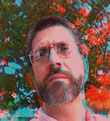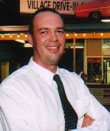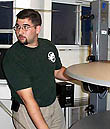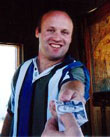|
|
This topic comprises 3 pages: 1 2 3
|
|
Author
|
Topic: More light? Is it possible?
|
|
|
Jerry Chase
Phenomenal Film Handler

Posts: 1068
From: Margate, FL, USA
Registered: Nov 2000
|
 posted 12-12-2000 07:11 AM
posted 12-12-2000 07:11 AM




I'm thinking that you might want to investigate a company called Protolite. I haven't seen mention of them in recent years, but they used to advertise a "Mirror Image" silver lenticular screen as a drive-in containment screen. The combo of lenticular and silver allowed them to get a _4.0_ gain screen across a standard DI field. The last address I have for them is 985 Timothy Drive, San Jose CA 95133 ph 408-971-9700.I have a little sample of their screen material. It can best be described as a very fine corduroy/canvas with a silver plastic overcoat. The stuff really works, AND increases the contrast, giving a better picture, because it rejects most of the ambient light, but could be pricey when covering a screen of that size. Still, the cost of a few 6KW lamps ain't cheap either, and this would be a lot easier on film and result in fewer burned fingers. While you're spending... Gratuities gladly accepted. 
| IP: Logged
|
|
|
|
Stefan Scholz
Expert Film Handler
Posts: 223
From: Schoenberg, Germany
Registered: Sep 1999
|
 posted 12-12-2000 11:58 AM
posted 12-12-2000 11:58 AM





Forget theidea of a bigger lamp. It is not worth the try. Some figures according to a Bauer sales leaflet from 1979:Lumen output of Bauer U 3 projector with single bladed 2880 rpm shutter (standard projector, not the drive in gear/ shutter type)
Horizontal Xenons, 35 mm film (1:1.17 window)
1600 Watts 10500 lumens
2500 Watts 13000 lumens
4000 Watts 14000 lumens. 7kW for 70 mm projection only. Will harm 35 mm even with air cooling of film. (Same statements from Strong's Super Lumex brochure.) Output 70 mm with 4 kW: 22000 lumens. It seems the maximum light output vs. lamp energy is around 2 kW.
The only way to get brighter images is the use of bigger film formats (no longer possible) or better transport to steady state relations, by use of specific "Drive In" projector gears.
Theese gears used to be more common, when Drive Ins were "bigger business", but still some makers advertise "Open Air" specials.
But maybe someone still has one of those accelerated gear projector mechanisms.
And of course the mentioned higher gain screens, which in turn narrow the usable angle, and which can be somewhat costly.
| IP: Logged
|
|
|
|
Jerry Chase
Phenomenal Film Handler

Posts: 1068
From: Margate, FL, USA
Registered: Nov 2000
|
 posted 12-12-2000 01:33 PM
posted 12-12-2000 01:33 PM




This got me curious about the edge falloff and gain of the silver Protolite screen, so I took my sample and stuck it in front of my slide projector to get a subjective view. Because of the bumps (lenses in very loose terminology) on the screen it is highly direcional in one direction, falling off rapidly if moved more than 15 degrees or so. In the other direction, it is quite forgiving and a decent image can be seen up to maybe a 60 degree angle. Dead on is of course the brightest, but it isn't as glarey bright as one gets from a matte silver screen. I don't know about a 4 gain, though. Subjectively, the picture looked maybe twice as bright, with little sparkleys in the brighter areas. These sparleys should be minimal once you get further back than a few feet like I was. A warning, if the screen tower is not properly canted toward the field, this type of screen could be worse than a matte screen. Reflecting back, (ouch) I've seen less expensive sheet vinyl wallcovering with vertical ridges. I wonder how this would reflect if painted silver?
| IP: Logged
|
|
John Pytlak
Film God

Posts: 9987
From: Rochester, NY 14650-1922
Registered: Jan 2000
|
 posted 12-12-2000 01:34 PM
posted 12-12-2000 01:34 PM





If you can find one in good repair, a 5:1 "drive-in" intermittent will allow you to decrease the shutter blades from about 90-degrees to 72 degrees, giving you significantly more light. They do tend to be noisier, and put more stress on the film perfs, but this should not be a major issue in a drive-in with durable polyester prints. A water-cooled gate is highly recommended for really large lamps, as the film and finger contacting components stay cool.Keep your screen surface in good repair, and paint it frequently. Someone mentioned using a mix of white and metallic paint to increase gain. If you do use a more "mirror like" surface, you may have a limited viewing angle, or need to curve the screen. Do all you can to shield the screen from stray lights like signs and streetlights. Consider the new "red barrel" Isco lenses, which are a new design that allow more light efficiency without significant loss of image quality. If that ORC lamphouse is the less efficient vertical design, consider going with a more efficient horizontal lamp. You don't really get much more light in going from 6K to 7K. Be sure your alignment is "on the money", and you are not "hot spotting" the film. Run a loop of a dark scene trailer a few hundred times to be sure you are not causing heat damage to the film. A silver-image black-and-white print would be the most sensitive to heat damage. ------------------
John P. Pytlak, Senior Technical Specialist
Worldwide Technical Services, Entertainment Imaging
Eastman Kodak Company
Research Labs, Building 69, Room 7419
Rochester, New York, 14650-1922 USA
Tel: 716-477-5325 Fax: 716-722-7243
E-Mail: john.pytlak@kodak.com
| IP: Logged
|
|
|
|
David Kilderry
Master Film Handler

Posts: 355
From: Melbourne Australia
Registered: Sep 1999
|
 posted 12-12-2000 05:31 PM
posted 12-12-2000 05:31 PM





Tim,A subject close to my heart! What follows is all tried and tested stuff on a circuit that once boasted 40 drive-ins! 1. You can run 7KW xenons in the right lamphouse. We run 7k with no scorch or hot gate problems in Kinoton lamphouses with water cooled gates and cold light mirrors. The gate is cool to the touch and the curved gate prevents popping. The light is brilliant. I imagine you can get similar results with Strong and Christie but have the heat shields in place! Today's modern efficient lamphouses leave stuff like the Bauers U3's mentioned in another era. They were good at the time and we used them in many drive-ins. If you cannot afford an upgrade here, run the correct lamp for your lamphouse and power supply. Keep mirror correctly aligned and clean, same with the glass heat shield. 2. Use a new lens from Isco or Schneider and keep it clean. If your lens has had drive-in use for over 8 years it is inefficient and costing you light and contrast. 3. Pull the port glass out and run blowers. 4. Use a light efficient projector as mentioned like a Century DAW. 5. Shield the screen from as much extreanous light as possible. Turn external flood lights away if you can, use trees and screening walls to remove all those man-made contrast killers -( term copyright John Pytlak and Kodak). If each of these gives you 6% more light, you will be 30% better off! That is a minimum from my experience. Most drive-ins have screens too big for today's field sizes and old equipment. The ones that do it right have good light. We put up with drive-in screens with 2 - 3 footlamberts for too long and the patron cannot always put a finger on why an indoor theatre looks better, but believe me it is one of the main reasons. On a 60 - 80 foot wide drive-in screen having 10 footlamberts is amazing to see. Good luck. David
| IP: Logged
|
|
|
|
Jerry Chase
Phenomenal Film Handler

Posts: 1068
From: Margate, FL, USA
Registered: Nov 2000
|
 posted 12-12-2000 08:56 PM
posted 12-12-2000 08:56 PM




I've not only got the material, I have the flyer that went along with it. You have to remember that I've been a 3-D nut for more years than most circuits have been in existence.I suppose that if you used this stuff rotated at 90 degrees, you could "plex" a single screen. Interesting idea, however I feel sure that it was meant to be used with the wide lateral viewing angles and a tight control top to bottom. Side views of many DIs are obscured by trees, but that shot over the back fence can be a killer. I seem to remember nickel coated screens being touted as a containment screen solution at one point. Scotchcal is a tough clear polyester film (Wait-a-minute! What is running through projectors?) and not a reflective product. Most of the reflective products it protects are made from glass micro beads that are only partially embedded in a paint or plastic. The beads take advantage of internal reflections within the sphere to aim the beam back along the axis of entry. Slick trick, but too directional for a decent movie screen. BTW, reflective beads don't hold polarization, so they don't work for 3-D. True containment screens would almost have to use the same type of black grid or slats in front of the screen that the pre-lenticular free vision 3-D pictures used. In any event, a silver screen with proper surface texture will greatly improve light levels. Outdoors, it might need periodic cleaning to maintain an even reflectivity.
| IP: Logged
|
|
Pat Moore
Master Film Handler

Posts: 363
Registered: Mar 2000
|
 posted 12-12-2000 10:55 PM
posted 12-12-2000 10:55 PM




Always the problem: How to get more energy through a small hole without burning film.Larger lamps generally produce more energy, but not necessarily more light. Light gain is NOT proportional to wattage. The ORC lamps you've got are not terribly light efficient. The newer technologies (am I allowed to mention STRONG) and reflectors are much more efficient in getting light through the aperture and into the lens. There's still the energy issue but you might as well do it with 4000W instead of 6 or 7000. The Simplex Projector probably has an adjustable two-wing shutter on it, so the opening can be increased. Assuming the film can "take the heat", adjust the shutter opening wider in 1/2-inch increments until you see ghosting appear top and bottom on test film. Then close up the opening slightly and you've maximized the efficiency of the projector for those conditions of projection. Again, watch the heat. By opening the shutter, the film is exposed for a longer time to the light energy. What lenses are you using? Since you've got a Reverse Anamorphic, I assume these are pretty long focal lengths. Lenses can make a difference in light throughput, and the nice thing is they are after the film. Good luck and keep us advised...
| IP: Logged
|
|
|
|
|
|
John Pytlak
Film God

Posts: 9987
From: Rochester, NY 14650-1922
Registered: Jan 2000
|
 posted 12-13-2000 08:25 AM
posted 12-13-2000 08:25 AM





Pat M., Mark G., Gordon M., John E., and others:Which projectors had optional 5:1 "drive-in" intermittents available? I have seen a rebuilt Simplex intermittent (from Wolk) with the additional linkage to give the faster pulldown, and heard there were others. ------------------
John P. Pytlak, Senior Technical Specialist
Worldwide Technical Services, Entertainment Imaging
Eastman Kodak Company
Research Labs, Building 69, Room 7419
Rochester, New York, 14650-1922 USA
Tel: 716-477-5325 Fax: 716-722-7243
E-Mail: john.pytlak@kodak.com
| IP: Logged
|
|
|
|
All times are Central (GMT -6:00)
|
This topic comprises 3 pages: 1 2 3
|
Powered by Infopop Corporation
UBB.classicTM
6.3.1.2
The Film-Tech Forums are designed for various members related to the cinema industry to express their opinions, viewpoints and testimonials on various products, services and events based upon speculation, personal knowledge and factual information through use, therefore all views represented here allow no liability upon the publishers of this web site and the owners of said views assume no liability for any ill will resulting from these postings. The posts made here are for educational as well as entertainment purposes and as such anyone viewing this portion of the website must accept these views as statements of the author of that opinion
and agrees to release the authors from any and all liability.
|

 Home
Home
 Products
Products
 Store
Store
 Forum
Forum
 Warehouse
Warehouse
 Contact Us
Contact Us




 Printer-friendly view of this topic
Printer-friendly view of this topic

















